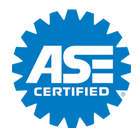SPRING STREET AUTOMOTIVE
Archive for March 2021Not a Good Vibe (Driveshaft Failure)Posted March 28, 2021 7:42 AMWhen you feel your vehicle vibrating as you're driving down the road, one cause could be something you may not have ever seen: your driveshaft. It is underneath the vehicle and most drivers don't climb under there to take a look very often. The driveshaft is a cylindrical part that helps conduct the rotational power from your engine to your drive wheels. If you have a four-wheel drive vehicle, you may have two driveshafts. The drive shaft has bushings, and when they wear out, that's a likely source of the vibrations. When the bushings are in good condition, they prevent the driveshaft from vibrating. And if you don't get your vehicle repaired fairly soon after discovering vibrations, they'll continue to get worse and cause other components of the drivetrain to wear out. The driveshaft is, of course, only one part of the drivetrain. It includes other parts such as axles, transmission, differentials and joints. They all work together and need to be maintained properly. When a driveshaft fails, there can be symptoms other than vibrations. They include difficulty turning, rattles, clunks and squeaks coming from underneath your vehicle. You may even feel a shudder when you accelerate from a stop. Driveshafts can fail when they get corroded or damaged by rough roads, curbs and debris. A trained technician with experience working on drivetrains uses specialized equipment that doesn't further damage the drivetrain's other parts. Sometimes the entire driveshaft will have to be replaced; sometimes the problems can be fixed by replacing individual components. Your vehicle's drivetrain was engineered to propel you smoothly down the road. When time and distance begin to take their toll, have your vehicle looked at by your service facility. They'll know how to properly pinpoint what's causing your problems and restore your vehicle to the reliable, smooth, safe machine its designers worked hard to create. Spring Street Automotive Inc The Spring Street Automotive Inc Guide to Vehicle DiagnosisPosted March 21, 2021 11:45 AMModern Quincy vehicles have several computers on board that control all kinds of things like engine functions, transmission shifts, traction control, anti-lock brakes, stability control, emissions – and on some vehicles, even steering, braking and the throttle. The Spring Street Automotive Inc Basic Guide To Synthetic OilPosted March 14, 2021 7:43 AMSynthetic motor oil has been around for a long time, and more and more new vehicles are leaving factories with synthetic in their engines. But a lot of drivers don't really know much about it. Spring Street Automotive Inc
1701 Spring Street
Quincy, IL 62301
217-228-9141
A Non-Starter (Alternator Problems in Cold Weather)Posted March 7, 2021 10:51 AMAs the temperatures dip, we all know there could be problems starting our vehicles. After all, batteries can grow old and not hold a charge as well as when they were newer. Or starters can go bad. But there's one more component to keep an especially sharp eye on during winter: your alternator. The alternator is sort of like a small generator. It sends power out to various parts in your vehicle that need electricity. That includes the battery, which needs charging to keep its power topped off. The alternator creates electricity by taking mechanical energy from the engine and turning it into electricity. It is connected to the engine by belts and pulleys. In cold weather, the material the belt is made from is less flexible than it is in warm weather. That means it may not be turning the pulleys as effectively since it doesn't have the same grip. Also, when it's colder, lubricants, including the engine oil, are a little stiffer and parts just don't move like they do when the weather's warmer. With that extra strain, sometimes it takes the alternator longer to recharge the battery. That, in turn, may leave the battery a little less power to start the engine when it's cold. You may have a warning light on your instrument panel that looks like a battery. If it lights up or if you notice your headlights flickering or not shining quite as brightly as they usually do, it could mean a weak alternator. But it also could be an aging battery, corroded battery terminals, a loose belt or another charging system part. Yes, it's complicated. Pinpointing the cause involves testing the battery and charging system with diagnostic equipment. If it does turn out to be an alternator, there are options besides replacing it with a brand new, original equipment part. Ask your service advisor for recommendations. Obviously, you want your vehicle to start reliably, especially in cold weather. Take care of your charging system and it will take care of you. Spring Street Automotive Inc | ||
SearchArchiveJune 2015 (3)July 2015 (1) September 2015 (2) October 2015 (5) November 2015 (3) December 2015 (3) February 2016 (2) March 2016 (4) April 2016 (4) May 2016 (5) June 2016 (4) July 2016 (4) August 2016 (5) September 2016 (4) October 2016 (4) November 2016 (5) December 2016 (4) January 2017 (5) February 2017 (4) March 2017 (4) April 2017 (3) May 2017 (5) June 2017 (4) July 2017 (5) August 2017 (3) September 2017 (3) October 2017 (4) November 2017 (5) December 2017 (3) January 2018 (5) February 2018 (4) March 2018 (4) April 2018 (5) May 2018 (4) June 2018 (4) July 2018 (5) August 2018 (4) September 2018 (5) October 2018 (4) November 2018 (4) December 2018 (5) January 2019 (5) February 2019 (3) March 2019 (5) April 2019 (4) May 2019 (4) June 2019 (5) July 2019 (4) August 2019 (4) September 2019 (5) October 2019 (4) November 2019 (4) December 2019 (5) January 2020 (5) February 2020 (4) March 2020 (5) April 2020 (4) May 2020 (5) June 2020 (4) July 2020 (4) August 2020 (5) September 2020 (4) October 2020 (4) November 2020 (5) December 2020 (4) January 2021 (6) February 2021 (4) March 2021 (4) April 2021 (4) May 2021 (5) June 2021 (4) July 2021 (4) August 2021 (5) September 2021 (4) October 2021 (5) November 2021 (4) December 2021 (4) January 2022 (6) February 2022 (4) March 2022 (4) April 2022 (4) May 2022 (5) June 2022 (4) July 2022 (5) August 2022 (4) September 2022 (4) October 2022 (5) November 2022 (4) December 2022 (4) January 2023 (5) February 2023 (4) March 2023 (4) April 2023 (5) May 2023 (4) June 2023 (4) July 2023 (5) August 2023 (4) September 2023 (4) October 2023 (5) November 2023 (4) December 2023 (5) January 2024 (5) February 2024 (4) March 2024 (5) April 2024 (3) | CategoriesMaintenance (46)Automotive News (8)Shocks & Struts (8)Tires and Wheels (33)Windshield Wipers (9)Battery (13)Air Conditioning (10)Serpentine Belt (5)Alignment (15)Brakes (17)Cooling System (16)Safety (5)Cabin Air Filter (6)Service Standards (11)Fuel System (39)Fluids (14)Fuel Economy (6)Older Vehicles (4)Service Intervals (9)Exhaust (8)Fuel Saving Tip: Slow Down (1)Transmission (8)Headlamps (4)Steering (8)Timing Belt (5)Diagnostics (5)Parts (7)Keys to a long lasting vehicle (4)Drive Train (8)Inspection (6)Monitoring System (3)Trip Inspection (2)Auto Safety (5)Check Engine Light (4)Winter Prep (3)Engine Air Filter (2)Alternator (4)Suspension (3)Dashboard (2)Warranty (1)Oil Change (6)What Customers Should Know (50)Wheel Bearings (1)Differential Service (3)Tire Rotation and Balancing (2)Safe Driving (1)Emergency Items (1)Tires (5)Diesel Maintenance (1)TPMS (2)Winter Tires (1)Customer Detective Work (1)PCV Valve (2) | |












